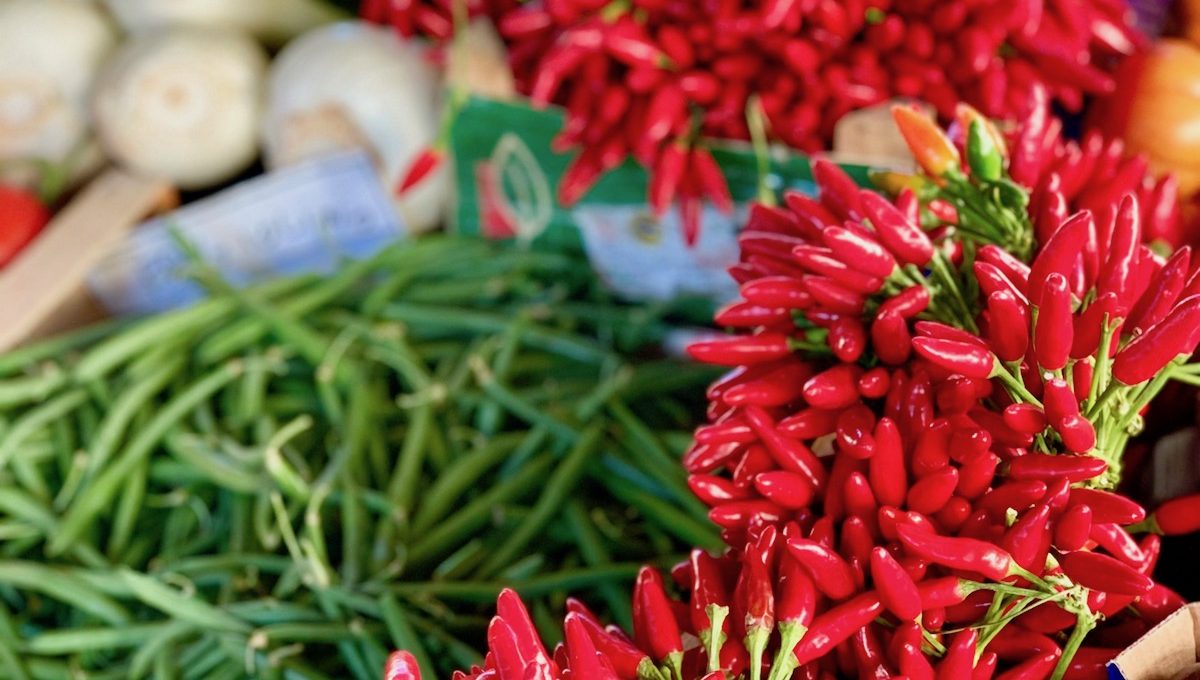
I’ve studied and worked in the culinary industry for a number of years. One topic I am particularly passionate about is sustainable/ethical and eco-friendly cooking. If you are wanting to learn more about sustainable cooking and how simple it can be then this post is for you.
I’ll be honest sustainable cooking can be daunting with the amount of information out there. Where should you begin? Should you go cold turkey vegan? Should you live off the grid? Most just give up on the idea and continue with day to day life even though deep down we all want to make some sort of positive impact on the environment.
I’ve compiled a list of 10 simple steps that can be implemented in the kitchen without drastically changing your lifestyle. Lets change the world from our kitchens with these simple habits for sustainable cooking.
1.Never waste fruit and veggie scraps
Every time we process fruits or vegetables we are always left with offcuts such as peels, seeds, cores, etc. Instead of throwing them away and wasting them we can use them constructively and creatively.
Plant them
Some fruits and vegetables are ideal for planting and can germinate very quickly. For example, growing tomatoes is easy. Next time you cut up a tomato, plant the seeds into a veggie patch or a pot and you’ll have little tomato plants sprouting in no time.
Other fruits and vegetables such as cucumbers, bell peppers, chilis, butternuts, pumpkins and melons can grow with relative ease. Rather than creating more waste, planting your offcuts may yield a lovely garden and save you money in the long run.
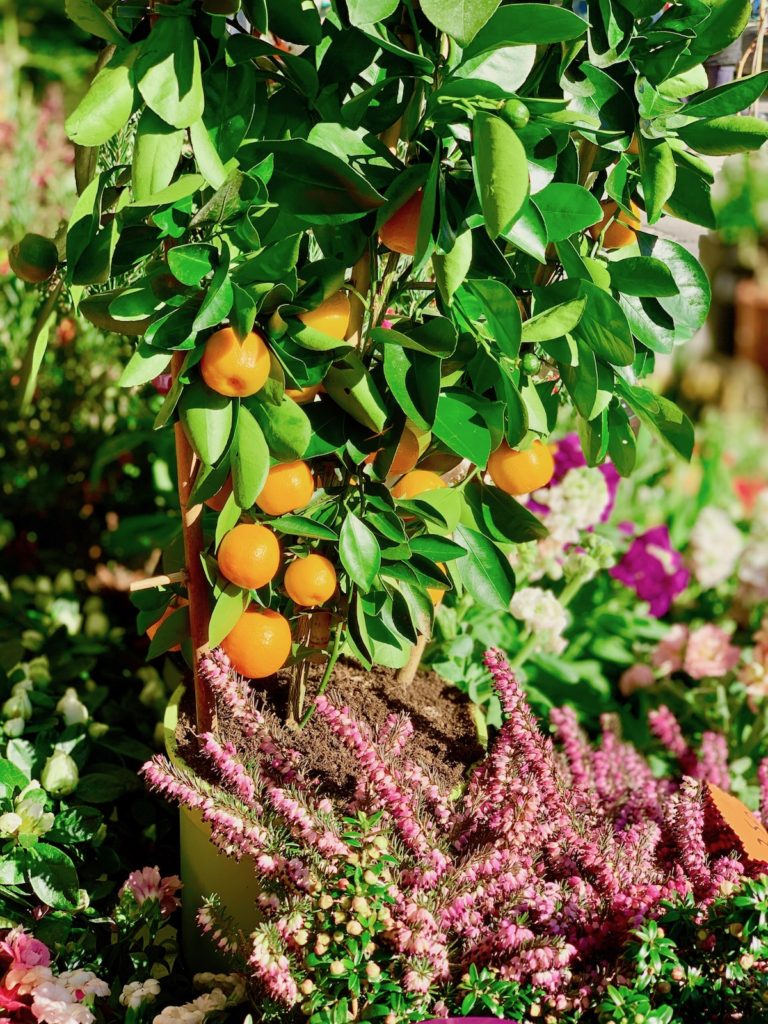
Make Stock
Stock is essentially flavored water that is used to add flavor into other foods such as sauces, risotto, soups, etc. Use vegetable offcuts to intensify the flavor of stocks. Veggies such as onions, celery, carrots, parsnips, celeriac and leeks never need to go to waste.
Tip: Some vegetables such as beetroot will release pigment into the stock. Avoid adding beetroot offcuts to your stock unless your aim is to make a pink risotto.
Compost
Having a compost heap/bucket means that literally no fruit or veggie leftovers need to be wasted. Every peel or wasted byproduct can be tossed into your compost heap. Be aware that if you have seeds in there you may have a few sprouts popping up every now and then.
Having your own compost heap can be very beneficial for fertilizing soil in your garden or your potted plants. If you live in an apartment and don’t have space, no worries! Apartment composting can still be an option for you.
Dehydrate
If you want to make your own spices then a great way to use vegetable offcuts is to dehydrate and pulverize them into a fine powder. To do this you need to set your oven to a low temperature, between 130 °F to 150 °F, then spread out the vegetable offcuts on an oven tray and leave it in the oven for several hours. The time needed to dehydrate will vary depending on the size of the off cut.
To test if it’s ready, take a piece and try to crumble it between your fingers. If it crumbles easily then it’s ready. You can use a blender such as a Vitamix to make the powder or do it old school with a pestle and mortar. My favorite powders to make using veggie scraps are onion, garlic, chili, red bell pepper and carrot. I use these powders to flavor stocks, marinades, rubs and sometimes I even incorporate them into bread recipes.
2.Vary your meats for sustainability
This is quite a controversial topic of conversation I have with people in my field. Should we cut out meat entirely? Not everyone wants to go vegan or vegetarian, I understand that. As a chef I enjoy making all kinds of food whether it’s vegetable based or meat based. So how can we cook meat in a sustainable way?
Always make sure you are buying meat that has been farmed ethically. Grass fed and free range meats are the way to go. Another way you can cook more sustainably is by varying the types of meat you eat.
There are a myriad of different meats such as lamb, pork, turkey, venison, ostrich, fish and shellfish. If you vary your diet it takes the burden off certain industries. The reason there is an over supply of something is because of over demand. Instead of having beef once or twice a week, try having beef once or twice a month and replace the beef you would’ve had with a different meat product.
Try out this model: Have meat based dinners 3 times a week, vegetarian dinners 3 times a week and then have leftovers on the last day of the week. If you have beef and chicken this week then next week switch to mutton and some kind of fish. Try to limit each meat type to once or twice a month.
I believe that sustainable cooking in this sense can have a profound impact. In my mind sustainability is the opposite of greed and gluttony. You don’t need to give up the things you enjoy in life, it’s all about balance over abundance.

3.Use less water and energy while cooking to be more sustainable
Sometimes we take for granted how much water we actually use and how much energy/electricity goes to waste when heating water. Below are a few simple habits we can change that can reduce the amount of water and electricity consumed in the kitchen.
Use a lid or cover
Whether you are boiling a pot of water to cook pasta or blanch veggies always use a lid. This prevents evaporation of water and holds the heat you have accrued in the pot. Not only will your water boil more quickly but you’ll save gas/electricity on heating too.
Boiling eggs more sustainably
When boiling eggs add just enough water to submerge them, making sure the water level is about half an inch above the eggs to account for evaporation. When it comes to boiling eggs I don’t use a lid because the water becomes too hot and over boils which risks cracking the egg shells due to turbulence in the water.
Moderating the water quantity can help you preserve water, reduce electricity and speed up the boiling process.
Save water when making tea
If you are using a kettle to make tea then only boil the water needed for the amount of cups you are going to make. It’s a simple concept and can save on electricity costs.
Save water when washing hands
Try to minimize running water used while washing hands. Decreasing the pressure of the faucet also adds up over time. You can use a low flow faucet aerator that cuts water usage without you even noticing.
4. Use the whole chicken
Rather than purchasing pre cut chicken pieces opt for buying a whole chicken and process it yourself. A whole chicken comes with 2 breasts, 2 thighs, 2 legs, 2 chicken wings and the carcass. If you buy a pack of 8 chicken breasts that means at least 4 chickens were slaughtered for that individual pack. If you scale that up the numbers get quite scary. However, buying a chicken whole and preparing it yourself yields loads of meat, can be less costly and is a simple start to sustainable cooking.
The whole chicken can be utilized including the carcass which can be used to make a chicken stock.
Try out this handy tip: Boil your chicken stock down until concentrated then freeze it in ice cube trays for home made stock cubes. If you have never deboned a chicken before then check out this tutorial and give it a go yourself.
5.Grow a veggie patch or herb garden for sustainable cooking
Growing your own vegetables and herbs is a commitment that can be very rewarding for you and the environment. You don’t need to have a huge area to grow a few veggies and if you live in an apartment then indoor potted herbs are a great option for you. Choose vegetables you enjoy eating and learn how to grow them.
The positive impact you can have on the environment
Herbs and vegetables in grocery stores are often sold in plastic packaging. By growing your own you eliminate the need for that plastic. This may be a small impact but it’s a positive one nonetheless and has a compounding effect.
What if you live in an apartment?
If you enjoy cooking with herbs then growing your own will be revolutionary for you. Even though I currently live in an apartment, I grow my own herbs and haven’t needed to purchase any in the last few months.
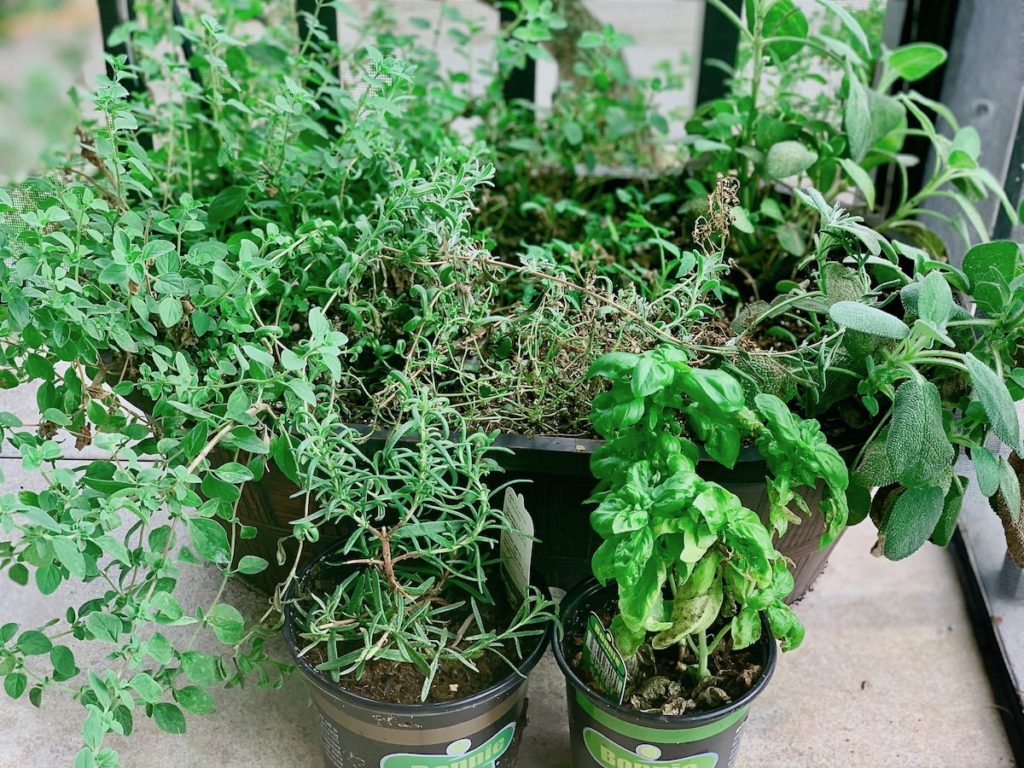
I bought myself a herb planter with rosemary, thyme, oregano, lavender, basil and sage and it turned out to be quite the investment. Instead of buying herbs for 3 – 5 bucks at a time, I spent 20 dollars on a setup that has supplied me with homegrown herbs for the last few months.
I could easily have spent about 100 dollars or more on herbs (I love to cook with them) but by making this once off purchase and minor commitment I am able to enjoy them at my leisure. Not to mention the dozens of plastic packages that would have been wasted had they been store bought.
Lastly, having planted herbs keeps them fresh, doesn’t take up space in the fridge and doesn’t go to waste as long as I am able to keep them alive.
Start your vegetable and herb garden today!
I have compiled a list of resources that can help you get started and give you more information about how to set up and look after a vegetable/herb garden.
- Vegetable garden for beginners
- Herb planter for apartment dwellers (with no balcony or natural incoming light)
- Growing veggies using offcuts
- Eco friendly DIY pesticides
- How to cut herbs correctly and encourage regrowth
6.Vary your diet for sustainability
Varying your diet is a good way to introduce sustainable cooking into your lifestyle. The idea here is to try new things and open up to new ideas when it comes to food. Use the following tips to help you switch up your diet.
Try out a new cooking techniques
From pan frying to blanching, roasting to broiling, curing to poaching there are countless techniques you can use to cook food. Some are simple and require minimalist equipment and others are more difficult and require experience to master. Nevertheless it’s important to improve your cooking skills to simplify your cooking and diversify your diet.
International cuisine
Try out new cuisine, this will expand your palate and open you up to a range of new ingredients that you never knew existed. Try cooking cuisine that is internationally known for being sustainable such as Indian, Lebanese, Vietnamese, Jamaican and most South/Central American cuisine. A simple Google or Pinterest search will find you anything you are looking for.
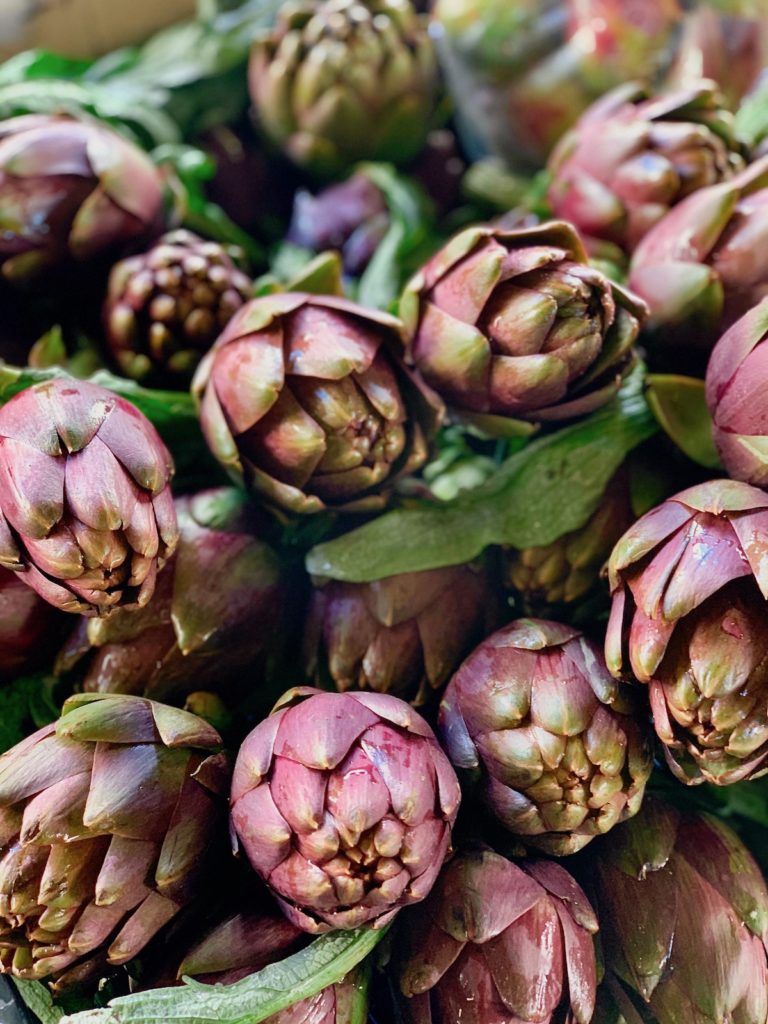
Find your favorite vegetable
It’s a fact that sadly far too many people do not like veggies. Maybe it’s because our parents force fed them to us as kids. Maybe they just did not know how to cook them properly. There could be a million and one reasons why a huge percentage of people do not like veggies but I bet those same people like at least one vegetable.
Find your favorite veggie and learn how to cook it multiple ways. Let’s take cauliflower for example. If you like cauliflower then try making 5 different dishes using cauliflower. Try cauli steaks, cauli rice, pickled cauli, cauli puree or cauliflower pizza bases… the list goes on and on.
Find your veggie, learn to cook it, enjoy it and then maybe try introducing something new. It’s a great way to allow veggies to creep into your diet but the idea is that you have at least one vegetable at every meal.
Create flavor for delicious food
A big factor that stops people from cooking their own food is that it doesn’t taste good. It’s very disappointing when you spend time cooking something and it turns out to be a bland chewy mess. What’s the point if it doesn’t taste good?
Learning how to create flavor in your food can be a very beneficial skill to have. Certain foods pair wonderfully with certain herbs and spices. For example: cauliflower and turmeric, chicken and paprika, pickled onions and thyme. Try out different combinations and find the ones that you enjoy.
Generating good flavor in your food starts right at the beginning of the cooking process. Let’s say for instance you are making a bolognese or some sort of pasta sauce. Always start by cooking the aromatics. This includes garlic, onion, shallots and hard leaf herbs like rosemary or thyme. Doing this creates a base of natural and delicious flavor that has a big impact on the end product.
Caramelization (the releasing of sugars through cooking) is a great way to give your food a more delicious flavor and texture. These ideas are just the tip of the iceberg on how you can improve the flavor of even simple ingredients.
Incorporate beans and lentils into sustainable cooking
Beans and lentils are a great way to bulk up your dinner. They are chock-full of nutrients and are very inexpensive. They can be used to bulk up stews, sauces, soups, pastas and more.
- Next time you make rice, add black beans in there with some finely chopped coriander for a hispanic style side dish. Top that off with some pan seared plantains or regular bananas and you’ve got yourself a full and delicious meal.
- Try pan frying a cup of mung beans for a popcorn flavored alternative that can be incorporated in your meal for added texture.
- Blend up some chickpeas, add some paprika, salt and pepper and use it as a dip.
The options are just about limitless.
7. Use the BBQ more often
Believe it or not cooking meals on the BBQ or an open fire is a great method for sustainable cooking. Some benefits include cutting back on electricity bills, gives food a delicious smokey flavor and brings family and friends together.
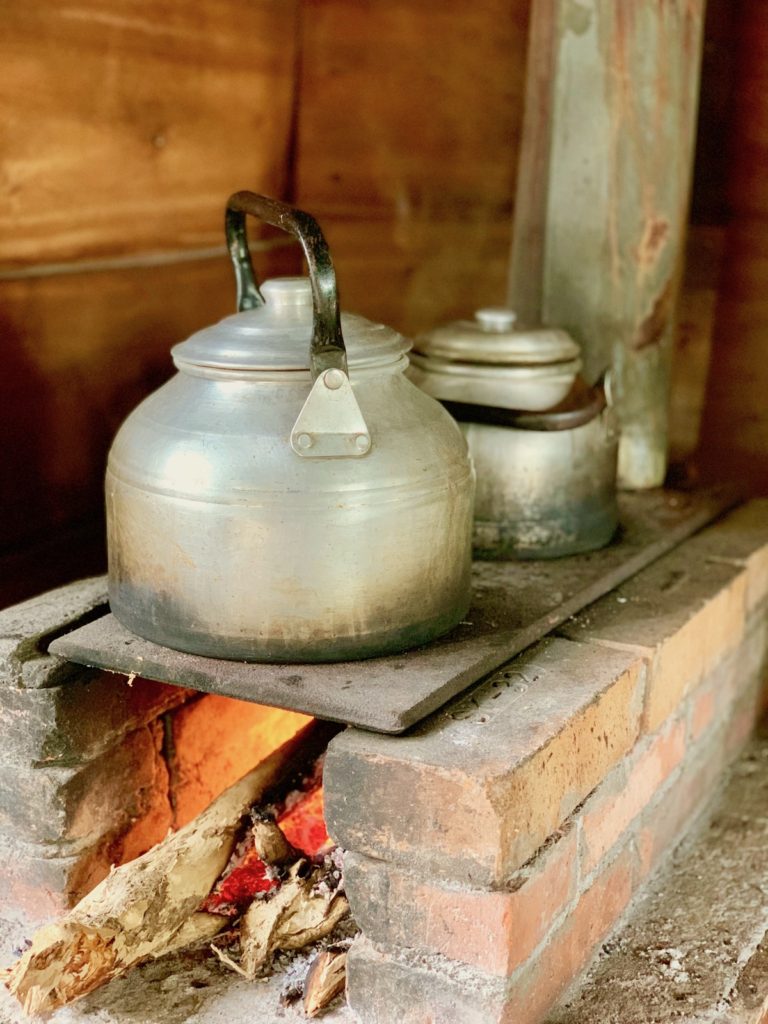
You can cook an entire meal on the BBQ all at once, including vegetables. If you are using pots and pans on the BBQ then make sure they are up to the task and will survive the flames.
Please take care when using an open flame. Don’t touch a hot pot or pan without some sort of protection. Using a gas BBQ is still more cost effective than running an electric oven or stove. I personally prefer the good old fashioned coal or wood fired BBQs.
8. Plan your meals and shopping list
This sustainable cooking habit may be tedious but it is definitely worth your time. Before going grocery shopping for the week spend ten minutes setting up a meal plan for what you will be eating during the week. Then go ahead and jot down the required ingredients for those meals. There is no need to over purchase food items that may be unhealthy or go to waste.
Having a meal plan and shopping list setup takes all the guesswork out of cooking and grocery shopping. You’ll save more time planning what you need before hand vs shopping ad-lib wandering up and down the aisles only to end up in the frozen food section because you had no idea what you felt like for dinner. I’ve been there too.
Use our free meal plan template and shopping list to get you started and check out our website for tasty meal ideas to help you fill out your meal plan.

9. Use reusable containers or alternative covers
If you were to ask me what I thought one of the biggest waste products out there was, I would probably say seran wrap or equivalent plastic wraps and plastic bags in general.
It is incredible how much plastic goes to waste for our convenience. Sure, I’m no saint when it comes to this, I’ve worked in kitchens for years and everything would get wrapped in plastic before being stored. It is common practice for restaurants and consumers alike to wrap left over food in plastic because it’s quick, easy and convenient.
How do we replace that aspect of our day to day life? Well we would need something equally quick, easy and convenient as a replacement. There are thousands of products out there created by people who are passionate about the environment and want to tackle this very problem.
Online shopping gives us the freedom to experiment with new products that are not so readily available at the grocery store and gives us the freedom of choice. Often this means supporting local and upcoming businesses that have creative new ideas aimed to help improve all life on this planet.
Below is a list of fantastic products that may work for you and your personal needs.
- Silicone baking mat
- Silicone stretch lids
- Glass storage containers
- Reusable grocery bag
- Reusable produce bags
- Silicone sandwich bags
- Beeswax reusable wrap
10. Proper preservation/storage of food to reduce waste
Food waste can be attributed to over purchasing, a point I covered earlier as well as improper storage. Understanding proper food storage can save you hundreds of dollars in wasted food and plays a vital role in sustainable cooking.
Here are a few storage tips to make the most out of your grocery purchases.
- Always check the use by date. If a store is selling something that has expired please notify a store manager immediately.
- Store refrigerated items in your fridge as soon as you get home. The longer raw food items are out of the fridge the more bacteria begins to grow and will result in them going bad before they need to.
- Freeze items for extended storage. For example, freeze leftover dinners like stews, soups, pasta and stir fries rather than refrigerating them. Chances are that leftovers will stay in the back of the fridge only to be tossed away a few days later.
- Store veggies like potatoes, sweet potatoes, onions and garlic in a cool dry area. Find a spot at the bottom of the pantry or make space in a cupboard. You will be surprised how long these veggies will last when stored in the right environment.
- Store leftovers in single use portions. It’s easier and more convenient to prep food this way. Always make sure that the container you are storing in is freezer friendly.
- If something in the fridge is about to go bad such as a meat product or seafood then cook it and freeze it for later use. You can extend it’s life this way. If it has gone beyond its use by date I would not recommend using it.
We can all develop habits towards sustainable cooking
There are many more ways than what I’ve mentioned on how we can make cooking more sustainable. However, the ideas I have presented above are simple and easy lifestyle changes.
Not everyone can do everything but if someone does something then that’s positive change. A small step in the right direction is still a step in the right direction.
If you meal plan and prep correctly, cook consciously and store food properly, you can really get a lid on the impact you are having on the environment.
Every step from purchase to preparation to storage has an overflow effect. Each step impacts the other, it’s a chain reaction. This chain reaction extends far beyond what we can see right in front of us.
Sustainable cooking is our choice and by changing a few simple habits we take for granted we really can make a positive impact on the environment without even noticing.
Teaching Kids About Sustainability
We have added a free downloadable activity pack for kids to get them engaged in the idea of helping out the environment. This activity pack contains 8 coloring pages, a recycling activity/game and some useful information about recycling.
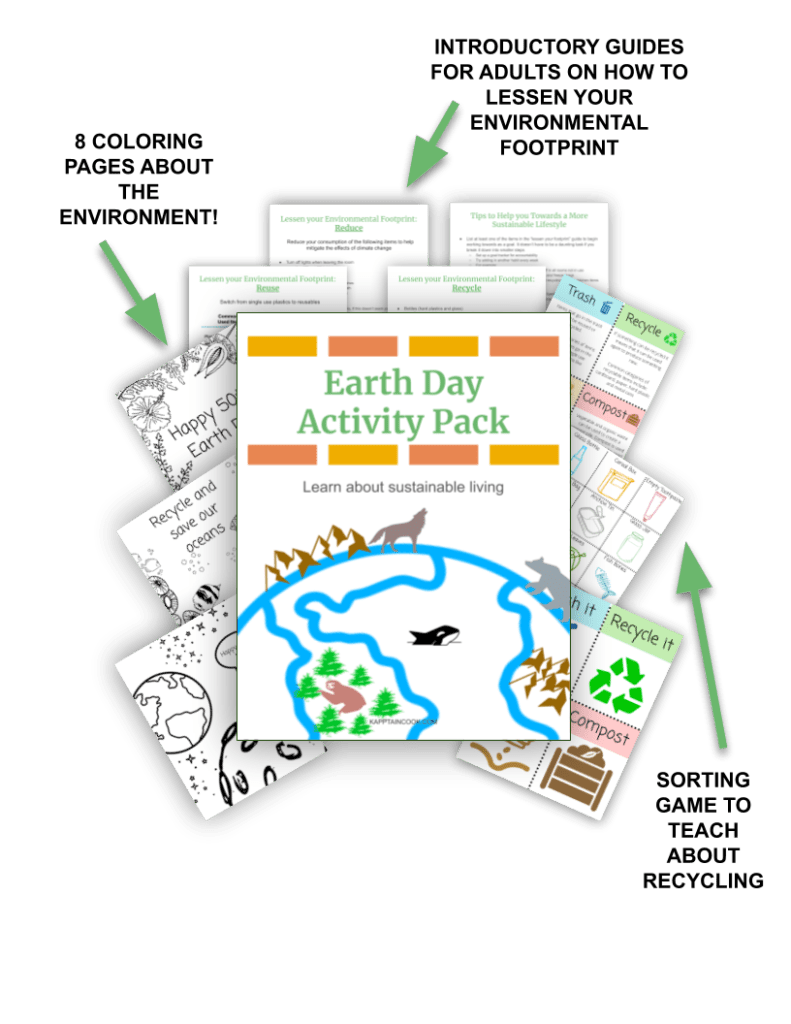
* This post contains affiliate links. While clicking on our link does not add any additional cost to you, it does provide a commission payment for qualifying purchases to Kapptain Cook, which helps us keep our site running.
